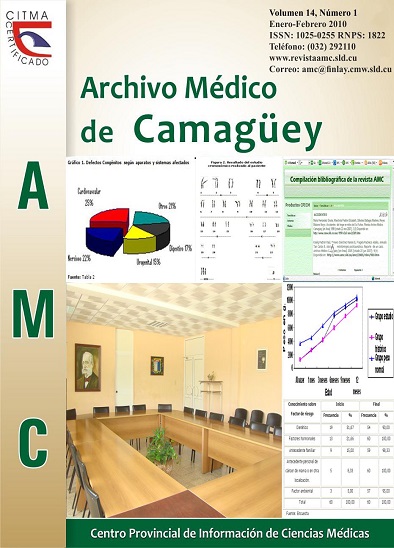Nivel de resistencia a la quinina más doxiciclina en la malaria cloroquina resistente
Abstract
RESUMENFundamento: la elevada incidencia de la resistencia a las drogas antimaláricas ha determinado que las estrategias de tratamiento se fundamenten actualmente en la asociación de por lo menos dos agentes diferentes.
Objetivo: determinar la respuesta a la combinación de quinina más doxiciclina en pacientes portadores de malaria cloroquina-resistente en la República de Gambia.
Método: se realizó un estudio cuasi experimental en ciento sesenta y cinco pacientes que presentaban formas no complicadas de malaria resistente a la cloroquina, ingresados en el Hospital Royal Victoria de Banjul, Gambia, en el período comprendido entre el 1ro de enero del 2006 al 30 de junio del 2007.
Resultados: la mayoría de los pacientes incluidos tenían menos de cuarenta y cinco años (75,15 %). El nivel de resistencia in vivo a la terapéutica analizada fue de 4,85 %. La mayoría de los pacientes presentaron al menos un efecto adverso, los más frecuentes fueron: vértigos, tinnitus e hipoacusia.
Conclusiones: el nivel de resistencia a la combinación estudiada resultó notablemente bajo, aunque con un elevado índice de efectos adversos.
Downloads
Downloads
Published
How to Cite
Issue
Section
License
Copyright: Camagüey Medical Archive Magazine, offers immediately after being indexed in the SciELO Project; Open access to the full text of the articles under the principle of making available and free the research to promote the exchange of global knowledge and contribute to a greater extension, publication, evaluation and extensive use of the articles that can be used without purpose As long as reference is made to the primary source.
Conflicts of interest: authors must declare in a mandatory manner the presence or not of conflicts of interest in relation to the investigation presented.
(Download Statement of potential conflicts of interest)
The Revista Archivo Médico de Camagüey is under a License Creative Commons Attribution-Noncommercial-No Derivative Works 4.0 International (CC BY 4.0).
This license allows others to distribute, to mix, to adjust and to build from its work, even for commercial purposes, as long as it is recognized the authorship of the original creation. This is the most helpful license offered. Recommended for maximum dissemination and use of licensed materials. The full license can be found at: https://creativecommons.org/licenses/













 22 julio 2025
22 julio 2025